Much to the annoyance of many gamers, whether video game violence causes real-world violence is a frequently studied topic in psychology. A definitive answer to this question, though, is still missing despite the fact that psychologists have been studying it for decades.
Or rather, there’s a lot of disagreement. Many politicians, researchers, and children advocacy groups point to lab studies, surveys, and meta analyses1 that show violent and aggressive behaviors follow exposure to violent games, and that their case is incontrovertible.2 Other researchers say that they can …controvert it. Is “controvert” a word? Let’s say “controvert” is a word. They do this by pointing to other studies and meta analyses that fail to show a link, as well as flaws in the theory and experimental designs of the opposing camp.3
I’ll get into the details of that debate another time, but the point is that the results of research on violence and aggression in games are mixed. There are several possible reasons why, but when I recently surveyed this literature it occurred to me that one may be that these studies have historically taken a very unsophisticated view of video games. Games differ widely in their design and so they surely differ widely in the ways that they interact with us and affect us psychologically. Some research, for example, shows that the context of the violence matters, and that shooting zombies while defending a teammate may affect our internal mental state differently than shooting the same zombies with the same weapons for no other reason than for sport.4
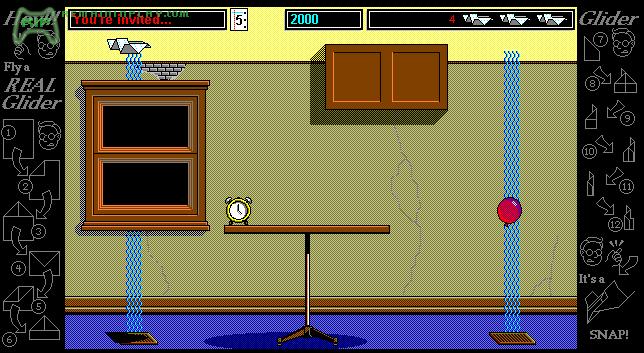
Glider Pro is an example of a nonviolent game typically used in research.
But it might be even more fundamental than that. A 2004 study by several of the biggest supporters of the “video game violence leads to real-world violence” camp found the results they were looking for when they had some subjects play a nonviolent game and others play a violent one. The researchers found that those who played the violent game had more aggressive thoughts and moods than those who played the nonviolent one. But let’s take a closere look. In the nonviolent game, Glider Pro 4, players use just two keyboard keys to guide a paper airplane through a simple, two-dimensional environment. The violent game, Marathon 2, is a standard first-person shooter where players uses a mouse and 20 keys to navigate through a complex, three-dimensional environment.
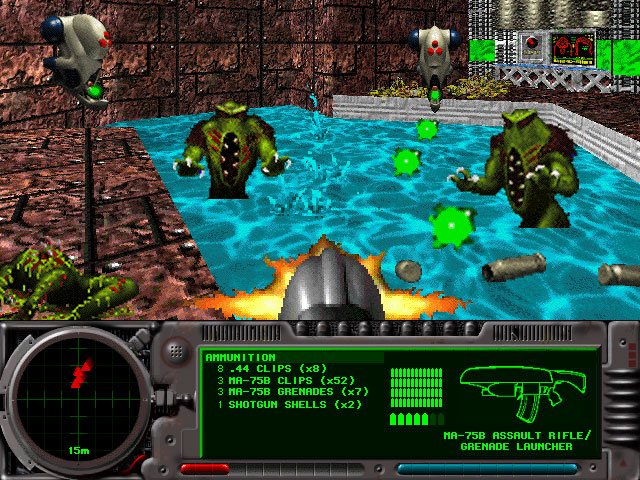
Marathon 2 is typical of the violent games used in research.
There is a possible problem with this design. The researchers concluded that the violent nature of Marathon 2 was to blame for the increase in aggressive thoughts and mood, but it might have been that the complex nature of the controls were too much for new players to feel like they could do what they wanted in the game. This could then lead to frustration and a slightly hostile mood. In research parlance, this difference in the control complexity between the games is known as a “confound” because it offers an alternative explanation for the results.
This is exactly the thought that Andrew Przybylski (pronounced “Shuh-Bill-Skee”) and his colleagues (pronounced “colleagues”) had, and it lead them to an interesting study that was just published in the Journal of Personality and Social Psychology.5 In that study, they wondered how much frustration over one’s inability to master game controls contributed to aggression, as opposed to the violent content of a game.
Przybylski and his colleagues used self-determination theory as a guiding framework for their research. In short, this theory posits that people are motivated to play video games to the extent that they scratch three psychological itches: the need to feel competent at what you’re doing, the need to feel like you have meaningful choices when deciding how to do it, and the need to feel connected and related to others in the process. The researchers posited that when controls are difficult to master, it thwarts the need for competence. This leads to frustration. Frustration leads to anger. Anger leads to hate. Hate eventually leads to blowing up Alderaan just to show some uppity princess who’s boss.
To test this idea, Przybylski and his colleagues conducted a series of seven experiments, including a recreation of the Glider Pro 4 vs. Marathon 2 study described above. They also modified Half-Life 2 Deathmatch to create a nonviolent version where opponents were painlessly tagged and teleported to a penalty box instead of being blown to bloody bits. My favorites, though, were Studies 3 and 6, where they had subjects play the most nonviolent game imaginable, Tetris, but then screwed with them.
In Study 3, half the subjects played Tetris with normal, intuitive controls (see Figure 1) while half of them played with controls that were deliberately made to be counter intuitive and difficult to master right off the bat (see Figure 2). Just imagine trying to remember that the triangle button was for moving left, but that the left trigger was for moving right and the square button was for instantly dropping a block to the bottom of the screen –all under constant time pressure. In study 6, the researchers moved beyond thwarting competence just by making the controls tricky; they actually increased the difficulty of the game. Subjects once again played Tetris, but for some of them the researchers thwarted their sense of competence by modifying the game so as to analyze the situation at the bottom of the board then give them the absolute worst possible block. Need a long, skinny block to slide into a 1×4 gap and complete four rows at once? Screw you. Here’s a 2×2 block. Feeling aggressive now?
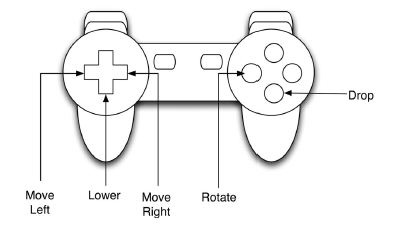
Figure 1, taken from Przybylski (2014)
All throughout the seven experiments, the researchers included measures of both control mastery, competence in general, and aggressive thoughts, emotions, and mental states. The short version of the results is that video games could make people feel aggressive and think violent thoughts simply by thwarting their sense of competence, either through difficult to master controls or general difficulty. This was true even in the absence of violent imagery.
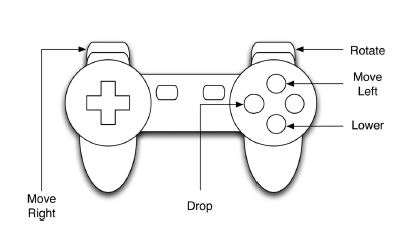
Figure 2, taken from Przybylski (2014)
This makes a lot of sense to me. Many of us have been in multiplayer matches where your team just plain sucks, and no matter what you do you can’t keep the opposition off the capture points or away from your flag. That undermining of your competence is frustrating and leads to rage quitting. So can difficult to use controls in any game. Just recently I was playing through the new Thief game and got frustrated with it when I couldn’t line Garrett up to jump up and grab a dangling rope so I could get him away from a patrolling guard. I actually pounded my desk in frustration after the third attempt because I felt that this should be SO SIMPLE yet I couldn’t do it.
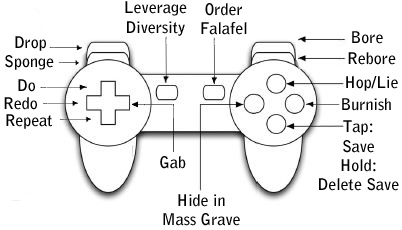
Figure 3, not actually taken from Przybylski (2014)
It’s worth noting that Przybylski et al.’s 2014 paper doesn’t address the question of whether or not violent games can make one violent, either in the short or long term. For example, it didn’t look at whether violent and nonviolent games with equal difficulty and frustration potential could affect children the same or differently. But that wasn’t necessarily the intent, Przybylski told me in an e-mail. The point was to show that games are complex, as are our interactions with them, and there are many theories about what makes for fun, frustrating, or enjoyable game beyond just how much red is on the screen. Alternative explanations for the effects of video game violence abound, and psychologists studying video games needs to better understand their nature and systems before designing research on them. This is why some of the best research on video games and psychology is starting to come out of people who grew up with the hobby and now getting established at universities and labs.
The violence in video games scene needs to move beyond simply “do they or don’t they” and look more carefully into what qualities of the game might or might not be more important for a variety of outcomes.



Very interesting study. Pryzblyski says the point was to show the complexity of games and their impacts on our minds, but it seem difficult to understand whether this demonstrated that hypothesis. It’s extremely interesting and valuable, but I think it also doesn’t really say anything about the question of the impacts of violent games on gamers, as you pointed out.
I think most arguments over the impacts of violence on people are coming from the social reinforcement angle (teaching and imparting lessons about violence which may then influence beliefs and behaviors). I’ve always thought the plain assumption that violent games makes gamers violent to be not only stupid, but offensive. Yet I can’t help but wonder if the violence we experience leaves similar impressions on us psychologically that actually being in a battlefield might leave. Of course the two aren’t precisely alike and the results will vary, but I think you get my point. The interactive nature of games leave very deep impressions on us, and in our catalogs of experience our minds don’t distinguish “real” violence from “fake” violence.
Yeah, Pryzblyski’s et al.’s main goal was to test the “frustration -> aggression” hypotheses, viz a viz self-determination theory. And they did that pretty thoroughly.
And you’re right on about the reasoning used by the “violent games cause violence IRL” camp. I’m writing the book chapter on that right now. They argue (and do research to support) that exposure to violent media (including games) causes people to form more mental associations with violence and aggression. And that triggers more violence-related mental scripts about how to behave. Violent games prime you to think violent thoughts, and with repetition those thoughts and ways of perceiving situations become more and more automatic and habitual. This leads to long-term changes in outlook and personality. There are other causes for real life aggression, but they argue that exposure to violent games is a significant risk factor. That’s the high level overview, anyway.
Pingback: Violence in Video Games | Ergonomics in Design
Nice podcast and a great interview! We also did some research on VG, frustration, and aggression: http://psycnet.apa.org/index.cfm?fa=search.displayRecord&id=55EA5BE4-0036-3C5B-CC06-8FCC5B0DC357&resultID=2&page=1&dbTab=pa&search=true
This is an incredibly interesting study and refreshing approach to issue of violence in video games and how it affects behavior. I have been doing a lot of research of my own on the matter, and in everything I’ve found so far nothing like this has come up. Everyone is so focused on and eager to explore how the game content is linked to behavior, but that’s only one factor. Other factors clearly need to be further explored, such as level exposure, age, personality type/tendencies, etc., but after reading this study I need to revise what I already thought was a solid opinion on the matter. How has this not been the focus of more studies? After reading up further on Pryzblyski’s work, this element as a contributing factor to generated negative behaviors make so much sense. Even in my own personal experience playing violent games as well as observing others play, I never thought about how the gaming hardware could be what’s inducing the frustration and aggression. Looking back, I can easily say that the majority of the times I’ve become frustrated with a game or seen others get frustrated, even through tantrums, at a game it was not because of the violent content, but either due to an inability to work the controls successful or an inability to pass a certain level of the game after several attempts. If studies like this one were brought to the forefront of this issue, it would completely change the game.
Pingback: Violent Video Games A Threat For Public Safety? | ahsantahireng210
Pingback: Frustrazione vs. violenza nei videogame: la realtà sui comportamenti aggressivi - Psicologo a Milano | Antonio Fresco
Pingback: Perchè alcuni videogame generano aggressività e violenza - Psicologo a Milano | Antonio Fresco
Pingback: Week 12 -Secondary research and Report writing. – EPQ Blog
Pingback: anastrozole online
Pingback: Frustration vs. Video Game Violence in Real-Life Aggression | The Psychology of Video Games – Shay Moradi — Organised